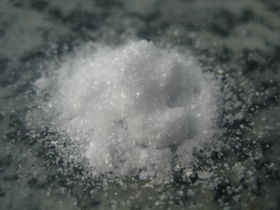Difference between revisions of "Barium chloride"
(→Chemical) |
|||
| Line 171: | Line 171: | ||
[[Category:Heavy metal toxicants]] | [[Category:Heavy metal toxicants]] | ||
[[Category:Easily prepared chemicals]] | [[Category:Easily prepared chemicals]] | ||
| + | [[Category:Essential reagents]] | ||
Latest revision as of 14:57, 18 November 2023
 |
This article is a stub. Please help Sciencemadness Wiki by expanding it, adding pictures, and improving existing text.
|
 Barium chloride crystals.
| |
| Names | |
|---|---|
| IUPAC name
Barium chloride
| |
| Other names
Barium dichloride
Barium muriate Muryate of Barytes | |
| Identifiers | |
| Jmol-3D images | Image |
| |
| Properties | |
| BaCl2 | |
| Molar mass | 208.23 g/mol (anhydrous) 244.26 g/mol (dihydrate) |
| Appearance | White crystalline solid |
| Odor | Odorless |
| Density | 3.856 g/cm3 (anhydrous) 3.0979 g/cm3 (dihydrate) |
| Melting point | 962 °C (1,764 °F; 1,235 K) (anhydrous) |
| Boiling point | 1,560 °C (2,840 °F; 1,830 K) |
| 31.2 g/100 mL (0 °C) 35.8 g/100 mL (20 °C) 59.4 g/100 mL (100 °C) | |
| Solubility | Soluble in methanol Insoluble in ethanol, ethyl acetate, toluene |
| Vapor pressure | ~0 mmHg |
| Thermochemistry | |
| Std enthalpy of
formation (ΔfH |
−858.56 kJ/mol |
| Hazards | |
| Safety data sheet | FisherScientific |
| Flash point | Non-flammable |
| Lethal dose or concentration (LD, LC): | |
| LD50 (Median dose)
|
78 mg/kg (rat, oral) 50 mg/kg (guinea pig, oral) |
| Related compounds | |
| Related compounds
|
Magnesium chloride Calcium chloride Strontium chloride Barium chlorate |
| Except where otherwise noted, data are given for materials in their standard state (at 25 °C [77 °F], 100 kPa). | |
| Infobox references | |
Barium chloride is the inorganic compound with the formula BaCl2. It is a soluble barium compound, useful for the preparation of various barium compounds.
Contents
Properties
Chemical
Barium chloride reacts with sulfates to precipitate barium sulfate.
- BaCl2 + SO4-2 → 2 Cl- + BaSO4
This reaction is used in identifying the sulfate species in a sample, though it also works with oxalates, phosphates or carbonates.
Reaction with sodium hydroxide gives barium hydroxide, which is moderately soluble in water.
- BaCl2 + 2 NaOH → 2 NaCl + Ba(OH)2
Electrolysis of aq. barium chloride solutions will yield barium chlorate[1] and barium perchlorate[2], depending on the current densities.
Barium chloride dihydrate (BaCl2·2 H2O) is stable in the air at room temperature, but loses one water of crystallization above 55 °C, turning into the monohydrate form (BaCl2·H2O), and becomes anhydrous above 121 °C. The monohydrate form can also be obtained from its dihydrate by stirring it in methanol.[3]
Physical
Barium chloride is a white solid, soluble in water and methanol, but insoluble in ethanol and alkanes.
Availability
Barium chloride can be purchased online.
Preparation
Can be prepared by reacting barium carbonate with hydrochloric acid. The solution is concentrated by boiling it and is then left to cool, which causes the barium chloride to crystallize.
A good method of obtaining barium chloride from pottery-grade barium carbonate can be found here.
Projects
- Sulfate test
- Make green flame
- Barium chlorate synthesis
Handling
Safety
Barium chloride, like the other water-soluble barium salts, is highly toxic if ingested. A soluble sulfate salt, such as sodium sulfate or magnesium sulfate can be used as antidotes, as they convert the soluble barium ions to the insoluble barium sulfate, which is relatively non-toxic.
Storage
Barium chloride should be stored in closed bottles.
Disposal
Barium chloride should be mixed with sodium sulfate or magnesium sulfate before disposal.
Gallery
References
- ↑ http://www.chlorates.exrockets.com/barium.html
- ↑ http://www.chlorates.exrockets.com/ba_perk_prep.pdf
- ↑ Kirk-Othmer Encyclopedia of Chemical Technology. 3rd ed., Volumes 1-26. New York, NY: John Wiley and Sons, 1978-1984., p. V3: 469 (1978)
Relevant Sciencemadness threads
- Article stubs
- Chemical pages without CAS Registry Number
- Articles without EBI source
- Chemical pages without ChemSpiderID
- Chemical pages without DrugBank identifier
- Articles without KEGG source
- Articles without InChI source
- Articles without UNII source
- Articles containing unverified chemical infoboxes
- Chemical compounds
- Inorganic compounds
- Barium compounds
- Chlorides
- Heavy metal toxicants
- Easily prepared chemicals
- Essential reagents
